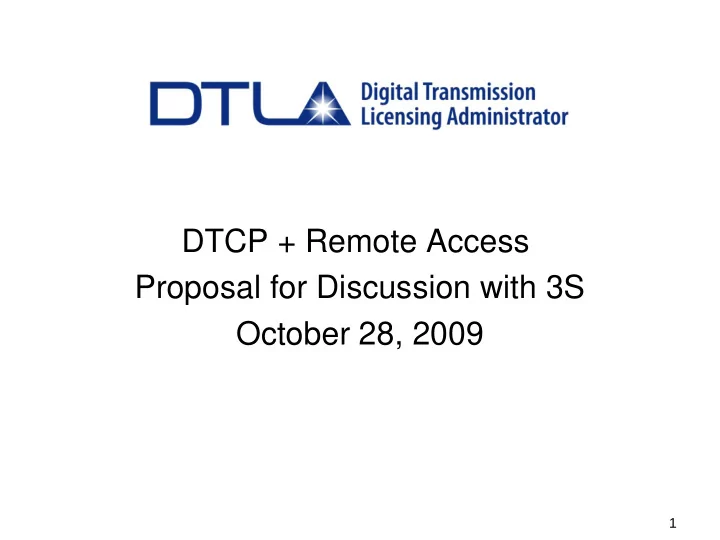

DTCP + Remote Access Proposal for Discussion with 3S October 28, 2009 1
Remote Access (RA) • Basic Rules • Remote Connection AKE • RA Encoding Rules 2
Remote Access Basic Rules • Source devices may permit remote access to content by 1 and only 1 sink device at any one time. Source Sink 3
Remote Access Basic Rules • Local access and remote access may be performed simultaneously Source Sink 4
Remote Access Basic Rules • A product that is actively remotely connected can be a source to other sinks on home/personal network in the remote location … Source Sink 5
Remote Access Basic Rules RA RA RA RA RA • However, no further simultaneous remote connections from local or remote sinks are allowed (no “ daisy chaining ” ) Source Sink 6
Remote Access Basic Rules • Source devices may add a sink device to their remote access device registry using “ local remote registration ” – Source devices perform DTCP authentication and register sink devices locally, before the sink may gain remote access. RA Device Registry Source Sink 7
Remote Access Basic Rules • “ Local remote registration ” includes – Successful local authentication of device with source – Passing current RTT localization checks • Source devices will permit remote connection only to sink devices on their remote access device registry – Remote connection is possible between a source device and one of sink devices pre- registered to that source device after the successful completion of Remote connection AKE protocol 8
Remote Connection AKE To obtain remote access to particular content: • Remote Connection AKE will check to see if the sink device is on its remote access device registry • The connection is permitted if no other device is remotely connected and the sink device is on the source device ’ s remote access device registry • Remote Connection AKE does not include localization checks – Localization capability already was confirmed during local remote registration – Remote RTT would prevent any remote connection. 9
RA Encoding Rule Cases • Live Content • DTCP Bound Recording • Other Recorded Media • Received from DTCP Source Function 10
Live Content Case For live content directly received by DTCP source: • RA is permitted in all cases for EPN marked content, regardless of any RA indicator that may be in the content • For CN and COG content, there may be an RA indicator in the live stream – If RA Indicator is present and is “Yes” then • RA is permitted for CN or COG – If RA Indicator is present and is “No” then • RA is not permitted for CN or COG – If RA Indicator is NOT present then • RA is NOT permitted for CN • RA is permitted for COG • Where a regulation of a government or quasi-governmental body is inconsistent with the above rules for CN or COG content, the regulation will apply for any DTCP Licensed Products made for sale in the jurisdiction subject to the regulation • Note: NMC is not an applicable marking for this situation 11
DTCP Bound Recording Case • This refers to content that has been copied by a Bound Recording method by a DTCP Sink Device and has been marked NMC or EPN – NMC or EPN marked content can be remotely accessible • Note: – CN and COG are not applicable marking for Bound Recordings – RA indicator is not carried forward – DTLA will adopt “anti-schmuck” language to prohibit RA where a live transmission marked COG is “copied” to an HDD (and, hence, is remarked NMC) and is then simultaneously sent for RA from the “copy” on the HDD, effectively overriding the live transmission rules 12
Other Recorded Media Case • This refers to content on removable media that device plays back, or content that has been recorded to any media other than by the DTCP Bound Recording method • RA is permitted in all cases for EPN and NMC marked content, regardless of any RA indicator that may be in the content • For content marked CN – If RA Indicator is present and is “Yes,” then RA is permitted – If RA Indicator is present and is “No,” then RA is not permitted – If RA Indicator is NOT present, then no RA is permitted • Note: COG is not an applicable marking. 13
Received From DTCP Source Function • No RA is permitted of any content during its reception from a DTCP source function. • This prevents daisy chaining when receiving content from a DTCP Source function via: – an RA connection (Remote) – a normal connection (Local) 14
DTCP + Remote Access Proposal for Discussion with 3S October 28, 2009 Thank you! 15
Recommend
More recommend